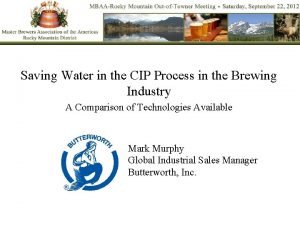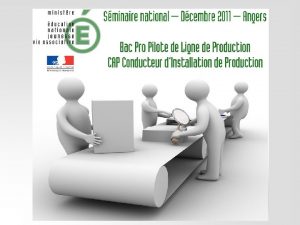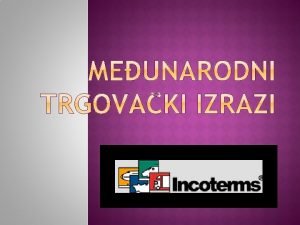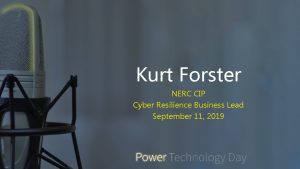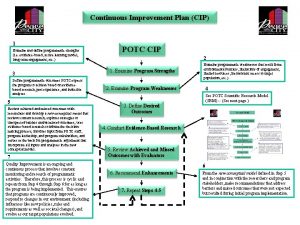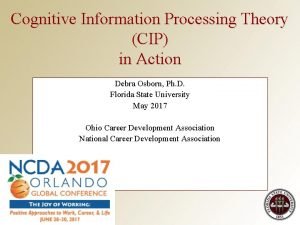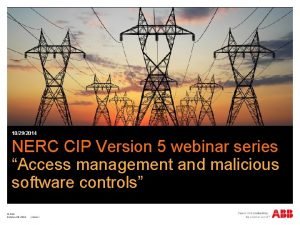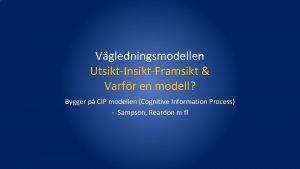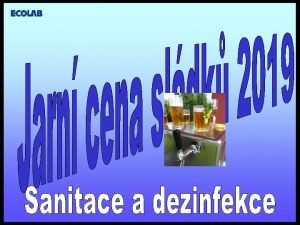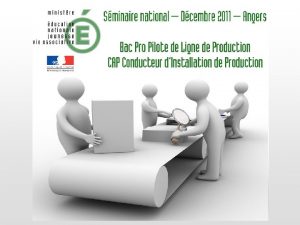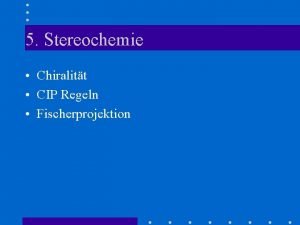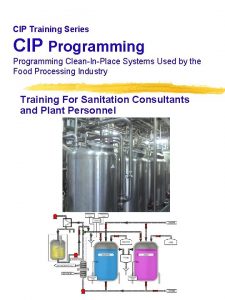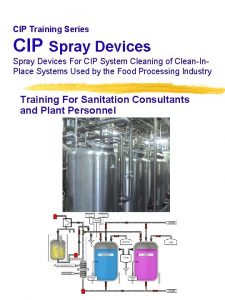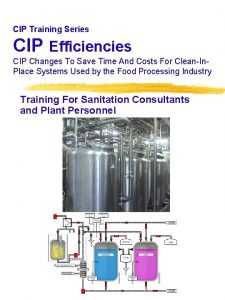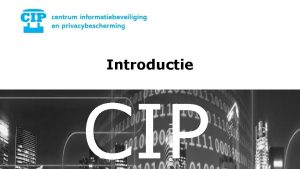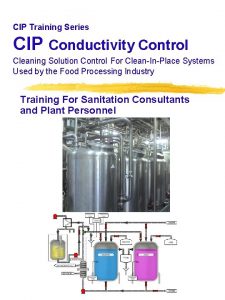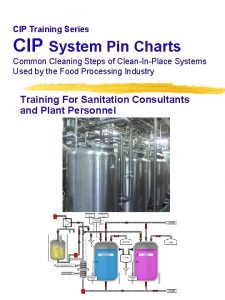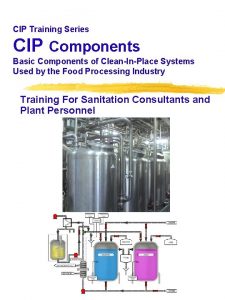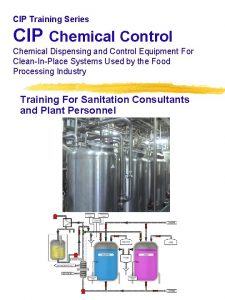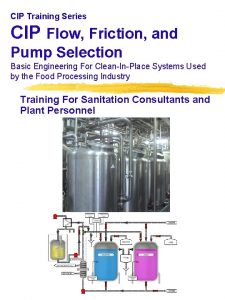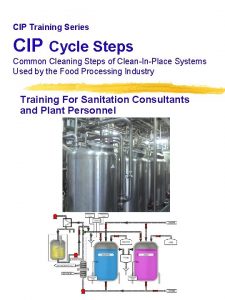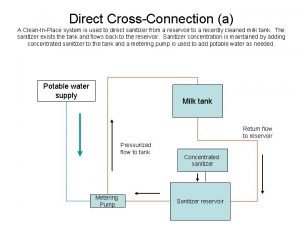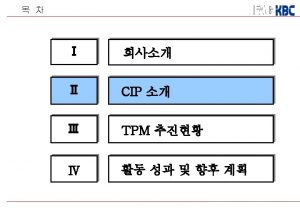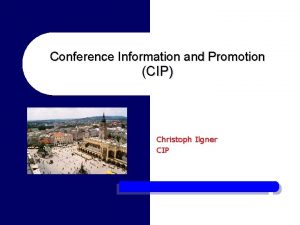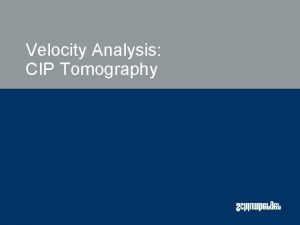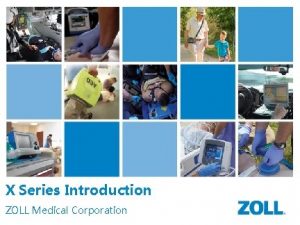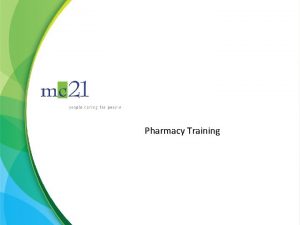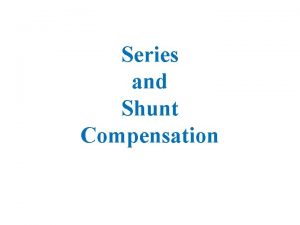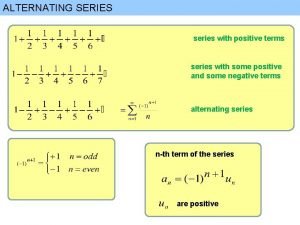CIP Training Series CIP Introduction to CleanInPlace Systems





















- Slides: 21

CIP Training Series CIP Introduction to Clean-In-Place Systems Used by the Food Processing Industry Training For Sanitation Consultants and Plant Personnel

CIP Introduction Clean-In-Place (A Little Personal History) From the point of view of one technical support chemist from Anderson Chemical Company in the sanitation industry: My experience with CIP starts in 1974. I call those CIP systems the “Model T” CIP systems -they did not have air valves, PLC controllers, CIP programs, remote temperature sensors or flowmeters -- in fact in those days they did not have control rooms. There weren’t any chemical dispensing systems -- the operator would manually add the chemicals to the system. When an operator was going to clean a piece of equipment he had to manually make/break pipe connections to make a CIP loop, then he had to open/close a series of plug valves to complete the circuit; he would manually fill the balance tank with water and manually add the cleaning chemicals (which were usually powders). Then he would push an on/off button to start the CIP pump. He would have to open a steam valve to heat the water and watch the temperature gauge until the cleaning solution was up to proper temperature. Finally he would use his wrist watch to time how long he would recirculate the cleaning solution. Remember, computers did not become commonplace until the 1980’s so the first CIP systems were manually controlled. The first automated CIP systems had Tenor drums controllers -have any of you worked with them? Basically the Tenor drum consisted of a round cylinder that had a bunch of pegs/holes which could open/close air valves, start/shut off recirculation pumps, control temperature, and time the length of the steps of a cleaning program. There a few of the Tenor controllers around, but they are considered “antiques” compared to today’s technology. In 1975 I saw my first “modern” CIP system at a cheese plant near Minneapolis. Basically they had built a whole new plant -- it had Tenor controllers. At the time this plant was considered “state of the art” and was a showpiece of modern food plant design. With the advent of computers (probably starting in the late 1970’s and early 80’s electrical engineers were able to design very complex logic systems for controlling all aspects of production and the CIP cleaning program. Today computers control and monitor most of the food manufacturing operation and the CIP cleaning processes. There have been many technical improvements in CIP systems since the “Model T” days in the early/mid 1970’s -- in those days there wasn’t any concern about flow rates, pressures, balanced supply/return flows, water conservation or CIP efficiency -- modern CIP systems are much more sophisticated and efficient than the early CIP systems that I worked on.

CIP Introduction Clean-In-Place Technology Benefits z Prior to CIP which probably started to become commonplace in the 1950’s food processing equipment was disassembled and the pipes and parts were manually cleaned in COP tanks. z With the advent of Clean-In-Place Technology provided numerous benefits y Convenience y Cleaning Effectiveness Improvements y Greater Sanitizing Efficacy y Labor savings y Time savings y Cost savings – Overall lower total operating costs

CIP Introduction CIP Technology – Benefits z The use of a CIP system greatly reduces or eliminates the need to disassemble equipment while improving safety to personnel, by minimizing contact with chemicals. z CIP systems allow equipment to be cleaned automatically at higher temperatures versus manual cleaning. Cleaner concentrations can be stronger and can also allow the use of aggressive chemicals (caustics, chlorinated alkaline cleaners, and acids). This allows the equipment to be cleaned more easily (minimal labor), safely (less exposure to chemicals), and more effectively (the more aggressive chemicals can be used at higher temperatures compared to manual cleaning). z Usually the controls for most modern CIP systems are integrated into the same microprocessor that controls their production processes. Engineering firms can also update older existing production equipment with modern PLC controllers which will manage both their production processes and the CIP cleaning programs.

CIP Introduction Clean-In-Place Technology z The advantage of CIP is improved product quality, repeatability/reliability of results in the cleaning of process equipment and piping; all at a lower cost. z Prior to CIP (i. e. , manual cleaning of equipment) there was a higher potential of equipment contamination during equipment reassembly. z (Well engineered) CIP systems may optimize operating costs and reduce waste. y Wash: Re-use of heat, water, and chemicals in the wash tanks y Rinse: Re-use of water (and to some degree heat and chemicals) in the rinse recovery tank. z CIP can be applied to any equipment that can be sprayed or recirculated under pressure (typically >25 psi or <100 psi). z COP (Clean-Out Of-Place) systems may be used along with CIP systems for cleaning of parts, tees, elbows, short piping sections and misc. equipment. COP may also be used to function as a simple CIP for small CIP circuits (to and from a small piece of equipment) and for short piping runs.

CIP Introduction CIP Technology z Product Recovery: Before cleaning a process, the CIP system can be used to recover residual product. z Examples are evacuation (pump-out or pump-down), airblow, pipe “pigging”, and water flushes (recovery of product from first burst rinse). z “Pipe pigging” uses a projectile (flexible elastomer) that is driven through the system by air or water, typically. This may be observed in receiving bays, for example. z The rinse method recovers product from the first burst rinse to be used in manufactured product for improved economies and to reduce waste/BOD.

CIP Introduction CIP Technology – Rinse Method of Product Recovery z In the rinse method the CIP system uses the first burst rinse to flush residual product from the equipment which is then reclaimed -- the benefit is not only recovering valuable product but also to reduce the amount of waste/BOD which would go down the drain. y Example: We have a dairy customer that was being charged by their POTW for the amount of BOD that they were discharging. We did a CIP validation study and discovered that their receiving bay was one of the largest sources of their BOD effluent. y The Solution: They installed what they call a “fat recovery” system which flushes the milk tankers with about 30 seconds of hot water and then they recover most of the milk solids and butterfat. Basically all they had to do was to make a few programming changes to their CIP programming to reclaim this product which normally would have went down the drain; so they are recovering the fat/milk solids and have greatly reduced their BOD issues.

CIP Introduction CIP Technology – Single-Use versus Re-use CIP Systems [Single-use: Wash solution is discharged to the drain after each CIP circuit. Re-use: Wash solutions are reclaimed for the next circuit to be washed. ] z Advantages and disadvantages to both systems. z The dairy and food processing industries use both single-use or re-use systems. z Re-use system cost savings. y There are cost savings in terms of energy (all the BTU’s are not sent down the drain). y Water is saved in terms of make-up water and effluent. y There are chemical savings (boosting chemicals instead of full chemical charges) for the small losses that occur through chemical reaction and in miscellaneous water losses caused during circulation and from solution return to the CIP tanks. z The advantage of single-use systems is specific control of cleaning solutions. A single-use system can be used to clean a wide variety of equipment with different degrees of soiling (heat-processed versus cold-processed for example). y Individual control of concentrations and temperatures provides excellent cleaning results. y Improved hygiene over re-use systems if the re-use system is badly managed (high soil levels).

CIP Introduction CIP Technology – Single-Use versus Re-use CIP Systems z The disadvantage of re-use systems is the lack of flexibility—a single temperature and concentration is often used for cleaning. This is fine if the CIP system is cleaning similar equipment having similar soils. y A re-use system should clean equipment having similar soils and processing conditions. Generally it should not clean extremes in equipment (widely divergent equipment and the soils that they may have). x Example: Whey lines from cheese vats versus the whey separator x Example: Cleaning milk silos versus the milk pasteurizer (HTST) y Also, poorly controlled re-use systems risk crosscontamination. Bacteria may survive in highly soiled reclaimed CIP solutions. y Single-use, eductor systems increase savings by circulating low volumes of water and cleaning solutions. z Modern PLC controllers/CIP systems can control different CIP circuits in re-use CIP systems at different concentrations and temperatures. However, control is not completely precise (especially with respect to concentration). y Example: If a circuit that requires control at a higher chemical level is followed by a circuit requiring a much lower concentration, then the 2 nd circuit will be at a higher chemical strength than desired.

CIP Introduction Cleaning Factors and Operation z The operation of a CIP system requires the control of the four factors of cleaning: y y Time (i. e. , Time at proper CIP temperature) Temperature Concentration Physical action x This is caused by turbulent flow in pipelines (shearing action on the metal surface). x This is also caused by the action of spray balls (impingement of the spray) on vessels and equipment internal surfaces and minimally by the sheeting action of flow down the sidewalls of equipment. x Rotational spay devices cause greater physical action throughout the internal vessel surfaces (see Spray devices Power. Point 5) x Physical action or Force = Flow Pressure/Area

CIP Introduction Cleaning Factors – Application of Physical Action z The cleaning of tanks and vessels require a variety of spray device designs to provide surface coverage and the cleaning factor of physical action. y Spray balls provide directional streams of water that facilitate cleaning by the cascading flow of solution down the vessel sidewalls. As mentioned, this is less physical force then can be provided through the means of rotational spray devices. y Rotational devices provide direct impingement on all surfaces by high pressure through 360° (i. e. , a complete circle in 3 -dimentions). x Rotational devices are not effective on very large tanks and silos (extremely high surface areas to cover).

CIP Introduction Cleaning Factors – Application of Heating/Temperature z The CIP system also provides the temperature cleaning factor by heating the water and cleaning solutions. The temperature of CIP solutions generally in the range of 135°F to 175°F, depending on the equipment cleaned and the soil level. Proper control is important. It is done through plate-and-frame heat exchangers or direct steam injection. y Heat exchangers are preferred for several reasons. This includes improved fine-tuned control of heating. y Direct steam may add steam to empty CIP tanks in extreme cases of poorly controlled CIP systems. y Direct steam contaminates solutions with boiler chemicals.

CIP Introduction CIP Wash Program z The CIP wash program involves a sequence of steps (cycles) that includes: initial drain, prerinse, wash(es), post-rinse(s), sanitize, and final drain. Wash programs vary by the needs of the process system to properly remove soil and sanitize the system to remove bacteria to acceptable levels. z Chemical concentrations are monitored and controlled generally by conductivity (in-line or intank probes). Setpoints are programmed in a PLC, PC, or sometimes the chemical supplier provides a separate chemical control panel. y The chemicals are added by air-operated dispensing pumps. Because most food soils are a matrix of different materials (protein, fat, mineral and carbohydrate) more than one cleaning chemical may be added to the wash cycle depending upon the nature of the soil and the fouling of the equipment. y This may include additional hypochlorite, a defoaming surfactant, or a chelate additive.

CIP Introduction Rinse and Rinse Recovery [The pre-rinse is used for gross soil removal -- usually the prerinse removes the bulk of the soil and thus this very dirty water is always diverted to the drain -subsequent rinses, either following the alkaline wash step or else the final rinse are usually “clean” water and thus sometimes this rinse water is diverted to a rinse recovery tank. Then the recovered rinse water is used as the prerinse on the next cleaning cycle. Water availability and water treatment costs are important issues today and when the rinse water can be reused it reduces their total water usage and thus their water and wastewater costs. ] z. The pre-rinse may use recycled water (rinse recovery) -- from previous alkaline wash water (after the alkaline tank high level probe is satisfied. It may also be post-rinse water. Loose soil is flushed out (which may be the bulk of the soil). y This water is directed to the drain, generally by a divert valve near the CIP unit.

CIP Introduction Post-Rinse and Sanitize z The post-rinse is usually the final rinse, and is discharged to the drain. It may be routed to a pre-rinse tank or rinse recovery tank for conservation and waste reduction. z If there are multiple cleaning steps (such as an alkaline wash step and an acid wash step) each step has a post-rinse. z Sanitizing is down at the end of the final rinse (or, the last post-rinse). y Acid sanitizers are most often used, since they are safe to leave on stainless (unlike chlorine sanitizers) and a rinse is not required to remove the sanitizer, risking contamination. y Peracetic acid (peroxyacetic acid) is very effective for a broad range of microorganisms and is approved for organic foods. It is also “environmentally friendly” (breakdown products are water, oxygen, and mild acetic acid – and the final breakdown organic is CO 2).

CIP Introduction Drain Steps [Because water drains by gravity in CIP systems it is important that the pipes and equipment is sloped to the drain points; if not there will be pools of residual water, soil and sometimes cleaning chemicals left in the equipment -- this is especially true on long pipeline circuits. ] z There are return pumps and liquid ring pumps. z Avoid sections of constricted flow in equipment and piping systems. Split flows can negatively impact cleaning. Re-engineer problem piping or develop proper SSOP’s as required. z Air-blow systems to improve return of water.

CIP Introduction Controls z There are many controls and interlocks incorporated into the CIP system are important; a variety of control instruments and sensors are utilized: flowmeters, pressure transducers, level sensors, temperature control RTD’s, conductivity meters (for control of cleaning solution concentrations and/or routing of rinse and wash solutions), alarms, etc. y CIP systems use PLC controllers to control: x Temperatures - throttling of steam valve x Flows - variable speed pumps x Concentrations - probe control of chemical feed pumps Sensors: Temperature Flow Conductivity

CIP Introduction PLC Controllers z The main control unit is usually a PLC or PC. y The PLC may have multiple panels to service operator stations (and for valve and I/O termination). z Modern process equipment is controlled by PLC controllers which control not only the production functions of the equipment but also the CIP programming and CIP components. For instance it controls VFD pumps, which are important to minimize hydraulic shock to the equipment. y It also controls the Proper sequencing and pulsing of automatic valves for cleaning valve seats, o-rings, and lip seals this helps ensure equipment hygiene and food product quality. z PLC controls are usually quite “user-friendly” but in order to achieve optimal results of the control system it is important to have well-trained operators and maintenance personnel. y User-friendly controls and instrumentation with welltrained operators and maintenance personnel are necessary for optimal results.

CIP Introduction CIP Validation [A properly managed CIP system must be validated after installation and startup. ] 1. Is the system working as designed? z 2. 3. The data obtained from the system sensors, instrumentation, and devices will tell you if proper heating, flow, and conductivity are occurring. To validate the sensors/instruments you will want to occasionally confirm their properation and accuracy of the with a temperature probe, portable flow meter, and by concentration test kit. Is the proper level of cleaning and sanitizing being achieved? Are the residual cleaning chemicals being removed from the equipment/piping? z z 2. and 3. above can be checked by simple tests on the final rinse water analysis: such as, p. H and ppm chlorine. Microbiological testing should be done. In more extreme cases, TOC (total organic carbon), HPLC (high performance liquid chromatography) can be used. Or simply, a COD test can be run. A riboflavin validation test can be run to check surface coverage by CIP spray. This is a visual check of the compound by ultraviolet light.

CIP Introduction Summary Basically, this first training module is just an introduction about the various components and functions of CIP systems. The information in this section will be repeated in greater detail in subsequent Power. Point Training Modules.

CIP Training Thank you for your time! Questions?
 Maclaurin series vs taylor series
Maclaurin series vs taylor series Heisenberg 1925 paper
Heisenberg 1925 paper Taylor series of composite functions
Taylor series of composite functions Maclaurin series vs taylor series
Maclaurin series vs taylor series Ibm p series
Ibm p series General feedback
General feedback Series aiding and series opposing
Series aiding and series opposing Arithmetic series vs geometric series
Arithmetic series vs geometric series What is nerc cip
What is nerc cip How to use less water in cip
How to use less water in cip Rc cip
Rc cip Paritet fca
Paritet fca Kurt forster
Kurt forster Cip 1
Cip 1 Qanxiety
Qanxiety Cip model
Cip model Cip theory
Cip theory Nerc cip webinar
Nerc cip webinar Cip modellen
Cip modellen Ansep cip
Ansep cip Cip up
Cip up Abgangsgruppe
Abgangsgruppe









